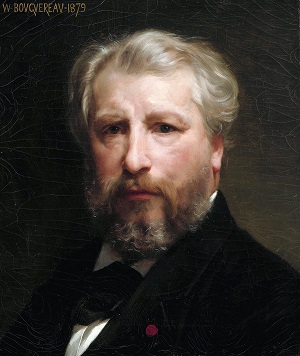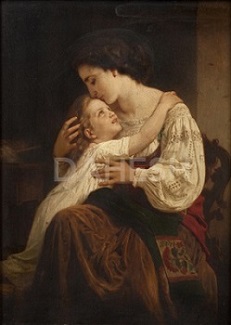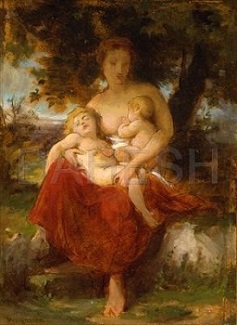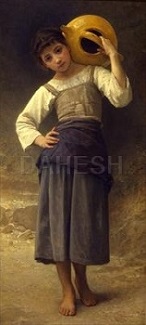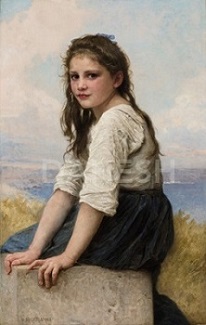Bouguereau’s “Amiable” Pictures Cross the Atlantic
William-Adolphe Bouguereau. “Who in America does not know that name? All those who pretend at all to taste for the fine arts certainly do,” wrote Outremer in The Aldine journal in 1877. One of France’s most successful artists in the second half of the 19th century, Bouguereau became an influential teacher, salon jurist, recipient of official and private commissions and numerous medals at the salons. The French Nation nominated him to the highest award of distinction, Grand Officer of the Legion of Honor, and inducted him into the Institute of France. His paintings and mass-marketed reproductions brought him wealth and international fame, especially in the United States.
Born in La Rochelle, France, in 1825, Bouguereau followed a typical academic course of study at the École des Beaux Arts in Paris, where he learned how to draw and accurately represent the human figure, gained knowledge of the myths, history, and ideals of Western civilization since Classical time, went through grueling competitions, and finally won the coveted Rome prize in 1850. When Bouguereau began his career in the 1850s, many changes were underway in the Parisian cultural scene: art was no longer only the domain of the aristocracy—church and state. The new buyers, the wealthy middle class, preferred scenes of everyday life, landscapes, and animal paintings to traditional large-scale representations of heroic historical religious or mythological themes. The rise in commercial art galleries also offered unprecedented new exhibition opportunities beyond the Paris Salon—the huge annual exhibition of contemporary art. By the 1860s, a new generation of American collectors looked to Paris, the art capital of the world, and the most sought-after French “Modern Masters” to decorate their homes and fashion their own cultural legacy.
To ensure his success in this fast-changing environment and carve a niche for himself, Bouguereau recognized that he had to adapt. He explored new subjects and modes of expression to keep in step with contemporary changes in aesthetic approaches, art market, and public taste. At the same time, Bouguereau maintained his commitment to the academic tradition’s emphasis on drawing, flawless finish, and ideal beauty. Beside religious and mythological subjects, which he continued to submit to the Salon, Bouguereau added “amiable” pictures of daily life scenes, ranging from images of young peasant girls engaged in rustic activity to those of mothers and children. He explained this transformation in an 1891 interview to L’Eclair. Pointing to his Equality before Death and Dante and Virgil (Musee d’Orsay, Paris) he said, “If I had continued to paint similar works, it is probable that, like these I would still own them. What do you expect, you have to follow public taste, and the public only buys what it likes. That’s why, with time, I changed my way of painting.”
Among his most popular themes were happy scenes of mothers and children, a secularized depiction of the Madonna and Child, a genre made popular by his friend Hugh Merle (1823–81) who collaborated with Durand-Ruel—Bouguereau’s first art dealer. Such tender pictures showing maternal love resonated with American collectors looking for narratives with a humanitarian emphasis. To keep up with the demand of his work, Bouguereau had to make reproductions of his important works, including reductions, such as Getting Up (ca. 1865).
Bouguereau spent much of his youth with his uncle, a parish priest, who instilled in him a love of the Bible. He also admired Renaissance depictions of the Madonna and Child (especially those by Raphael) with their seductive smile, grace, and simplicity, as we are told by Marius Vachon in his biography of Bouguereau. Study for Charity (ca. 1872) is an example. This preparatory sketch—for a painting (location unknown) commissioned by the dealer George A. Lucas for his client, collector and dealer Samuel P. Avery—exemplifies one of the major steps in producing an academic painting. After preliminary pen, pencil, or graphite drawings, the oil sketch was used to experiment with compositional color relationships.
Another favorite subject was that of an idealized peasant girl dreamily engaged in a rustic activity. In this painting, the young girl’s figure echoes Greek and Roman statuary, Renaissance paintings, and the Neoclassicism of Jean-Auguste Dominique Ingres (1780–1867), whose famous composition entitled The Source (1856, Musée d’Orsay) was a direct precedent for The Water Girl (1885). The artist sold the painting to Goupil & Cie—with whom he had an exclusive contract from 1866 to 1887, who in turn sold it to Reichard & Co. of New York in 1866. That year New York collector Eugene Hoffman acquired it, and the canvas stayed in the family until its purchase by the Dahesh Museum of Art in 1995.
Another idealized peasant appears in By the Sea (1903). This charming young model from the artist’s hometown of La Rochelle typifies Bouguereau’s tender and graceful girls, whose souls are captured by the artist. Placed in the foreground and looking directly at the viewer, her thoughts seem far away and ambiguous. The artist sold the painting to Arthur Tooth & Sons in 1903, who immediately sold it to the New York gallery Knoedler & Co. Milwaukee based dealer Henry Reinhardt & Co. then acquired it and in 1905 sold it to Richard Taylor Robinson, where it remained in the family until purchased by the Dahesh Museum in 2013.
Indeed, Bouguereau was a man of his time. He made changes to appeal to popular taste but remained true to his academic roots, above all believing that art defines the search for ideal beauty, as he noted: “In painting, I am an idealist. I see only the beautiful in art and, for me, art is the beautiful.” Modernism’s triumph at the end of the 19th century, pushed Bouguereau out of favor, until in the later 20th century when scholars and collectors rediscovered realist and figurative art. In a recent exhibition at the Norman Rockwell Museum, the American illustrator and historian Denis Nolan, writing about his own art education, noted, “Standing in front of Bouguereau [paintings] … confirmed how much I still had to learn. I was humbled by their precise draftsmanship and technical prowess, and stood in awe of their abilities.” And the celebrated American artist, Audrey Flack—best known for her contribution to the Photorealism movement—noted simply in a July 2021 podcast, “I love Bouguereau, he is a beautiful painter.”



